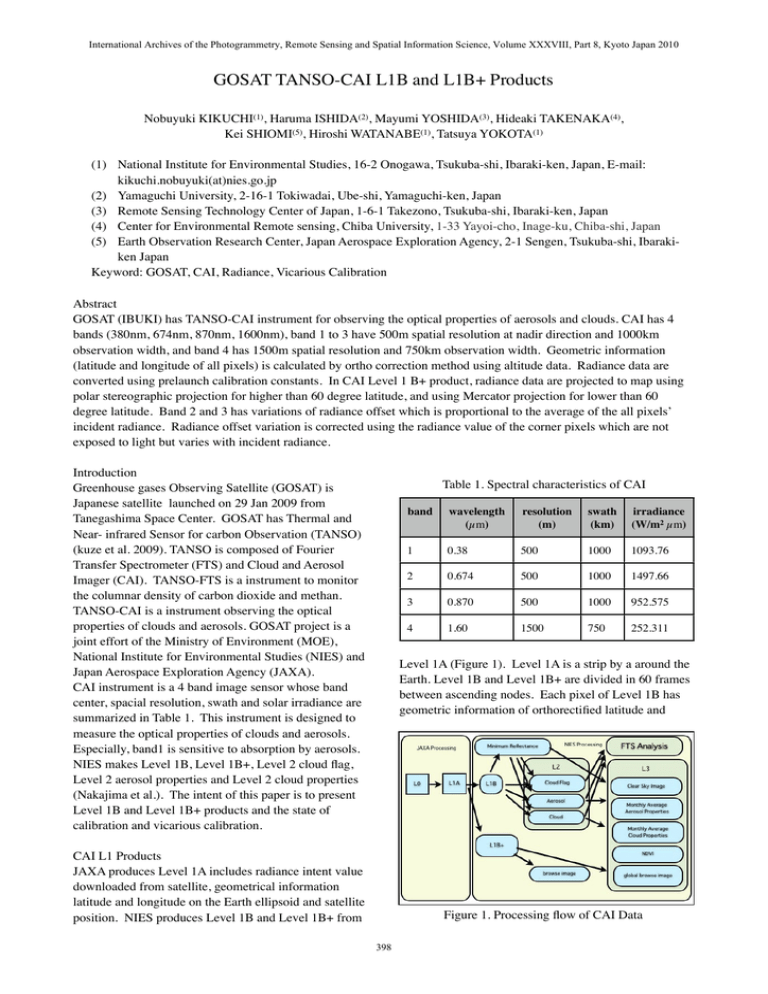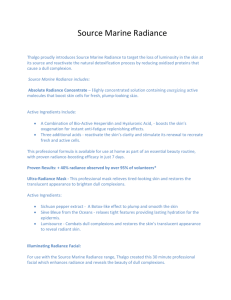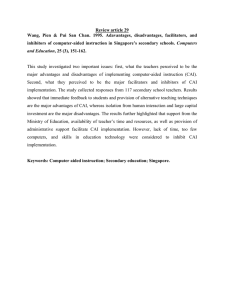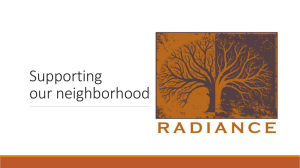GOSAT TANSO-CAI L1B and L1B+ Products
advertisement

International Archives of the Photogrammetry, Remote Sensing and Spatial Information Science, Volume XXXVIII, Part 8, Kyoto Japan 2010 GOSAT TANSO-CAI L1B and L1B+ Products Nobuyuki KIKUCHI(1), Haruma ISHIDA(2), Mayumi YOSHIDA(3), Hideaki TAKENAKA(4), Kei SHIOMI(5), Hiroshi WATANABE(1), Tatsuya YOKOTA(1) (1) National Institute for Environmental Studies, 16-2 Onogawa, Tsukuba-shi, Ibaraki-ken, Japan, E-mail: kikuchi.nobuyuki(at)nies.go.jp (2) Yamaguchi University, 2-16-1 Tokiwadai, Ube-shi, Yamaguchi-ken, Japan (3) Remote Sensing Technology Center of Japan, 1-6-1 Takezono, Tsukuba-shi, Ibaraki-ken, Japan (4) Center for Environmental Remote sensing, Chiba University, 1-33 Yayoi-cho, Inage-ku, Chiba-shi, Japan (5) Earth Observation Research Center, Japan Aerospace Exploration Agency, 2-1 Sengen, Tsukuba-shi, Ibarakiken Japan Keyword: GOSAT, CAI, Radiance, Vicarious Calibration Abstract GOSAT (IBUKI) has TANSO-CAI instrument for observing the optical properties of aerosols and clouds. CAI has 4 bands (380nm, 674nm, 870nm, 1600nm), band 1 to 3 have 500m spatial resolution at nadir direction and 1000km observation width, and band 4 has 1500m spatial resolution and 750km observation width. Geometric information (latitude and longitude of all pixels) is calculated by ortho correction method using altitude data. Radiance data are converted using prelaunch calibration constants. In CAI Level 1 B+ product, radiance data are projected to map using polar stereographic projection for higher than 60 degree latitude, and using Mercator projection for lower than 60 degree latitude. Band 2 and 3 has variations of radiance offset which is proportional to the average of the all pixels’ incident radiance. Radiance offset variation is corrected using the radiance value of the corner pixels which are not exposed to light but varies with incident radiance. Introduction Greenhouse gases Observing Satellite (GOSAT) is Japanese satellite launched on 29 Jan 2009 from Tanegashima Space Center. GOSAT has Thermal and Near- infrared Sensor for carbon Observation (TANSO) (kuze et al. 2009). TANSO is composed of Fourier Transfer Spectrometer (FTS) and Cloud and Aerosol Imager (CAI). TANSO-FTS is a instrument to monitor the columnar density of carbon dioxide and methan. TANSO-CAI is a instrument observing the optical properties of clouds and aerosols. GOSAT project is a joint effort of the Ministry of Environment (MOE), National Institute for Environmental Studies (NIES) and Japan Aerospace Exploration Agency (JAXA). CAI instrument is a 4 band image sensor whose band center, spacial resolution, swath and solar irradiance are summarized in Table 1. This instrument is designed to measure the optical properties of clouds and aerosols. Especially, band1 is sensitive to absorption by aerosols. NIES makes Level 1B, Level 1B+, Level 2 cloud flag, Level 2 aerosol properties and Level 2 cloud properties (Nakajima et al.). The intent of this paper is to present Level 1B and Level 1B+ products and the state of calibration and vicarious calibration. Table 1. Spectral characteristics of CAI band wavelength (µm) resolution (m) swath (km) irradiance (W/m2 µm) 1 0.38 500 1000 1093.76 2 0.674 500 1000 1497.66 3 0.870 500 1000 952.575 4 1.60 1500 750 252.311 Level 1A (Figure 1). Level 1A is a strip by a around the Earth. Level 1B and Level 1B+ are divided in 60 frames between ascending nodes. Each pixel of Level 1B has geometric information of orthorectified latitude and CAI L1 Products JAXA produces Level 1A includes radiance intent value downloaded from satellite, geometrical information latitude and longitude on the Earth ellipsoid and satellite position. NIES produces Level 1B and Level 1B+ from Figure 1. Processing flow of CAI Data 398 International Archives of the Photogrammetry, Remote Sensing and Spatial Information Science, Volume XXXVIII, Part 8, Kyoto Japan 2010 longitude using altitude. In the CAI Level 1B product, all bands are registered to 0.5 pixels selecting the nearest neighbor pixel. Level 1B+ radiance data are projected on the Mercator projection for +60 degree latitude to -60 degree latitude or polar stereographic projection for higher than +60 degree latitude of lower than -60 degree latitude. Band to band registration is not corrected in Level 1 A but corrected in Level 1 B and 1B+. Radiometric calibration Radiometric calibration of CAI is obtained by measuring the output of a integrated sphere maintained at JAXA. The integration sphere is calibrated with black body. Conversion function from sensor output to radiance is a liner and Scale and Offset are given by Scale = Radiancecalibration × integrationTime (DN calibration − DarkLevel) Offset = DarkLevel . where DN calibration is sensor output, Radiance calibration radiance measurements of the integration sphere, DarkLevel measurements of the dark target, integrationTime sensor Figure 2. Scatterplot of radiance simulated from MODIS vs CAI. Upper graph is for band 2, lower graph band3. integration time. Using Scale and Offset , sensor output is converted to radiance as Radiance = Scale × (DN − Offset ) integrationTime We found a problem in CAI radiance data whose dark level are affected with incident light in the field of view. CAI L1A products has pixels in the corner of a strip where light does not reach. These pixel’s value show variation proportional to the average of all pixels on the cross-track line. In figure. 3, the image above is a browse image of band 2 , the graph below is sensor outputs of the band 2 corner pixels as a function of the along-track line number. Fig. 3 shows that variation of sensor output in the corner pixels is relative to brightness variation in the browse image. Due to investigation of the corner pixels, the point at problem of the dark level variability become clear. It is expected that the variation of offset of the corner pixels shows the variation of offset of the all pixels. We assumed the value of dark level of each pixel is corrected with the value of the . Vicarious Calibration After launch, vicarious calibration coefficients for CAI are determined by comparing with Aqua MODIS radiance data looking at the same area at the same time. Avoiding BRDF (bidirectional reflectance distribution function) effects, MODIS sensors’ radiance are converted to the radiance in the observing geometry of GOSAT using the radiative transfer theory through the aerosol and cloud optical properties. Band 2 and 3 radiances are compared with MODIS radiances through the aerosol optical thickness in dark region, and the cloud optical thickness in bright region. Band 4 are compared with MODIS radiance through the cloud particle radius. Unfortunately MODIS doesn’t have 380 nm channel, band 1 radiance simulated from band 2 and 3, radiance using radiative transfer theory through aerosol optical properties. Equation of vicarious calibration is described with a liner function, and coefficients are shown in the table. Fig. 2 is scatterplot of radiance of simulation through aerosol optical thickness from MODIS and CAI which show that CAI radiance is brighter than MODIS radiance and uneven. Fig. 3. Image of the measured reflectance of band 2 (above), and Sensor outputs as a function of line number (below). Zero level correction 399 International Archives of the Photogrammetry, Remote Sensing and Spatial Information Science, Volume XXXVIII, Part 8, Kyoto Japan 2010 corner pixels. First we have applied the correction method derived theretofore to the derivation of calibration coefficients using the integration sphere. Corrected scale is given by Table 2. Vicarious calibration coefficients of CAI band slope offset correctioncal = DarkLevel side − DN side_cal 1 1.138 0.00 Radiancecal × integrationTime 2 0.946 -1.372 3 1.033 -0.189 4 1.144 0.00 Scale′ = (DN cal − (DarkLevel − correction cal )) where DN side is the average value of the corner pixels divided to odd pixels and even pixels where 4 pixels for lowest number and 4 pixels for largest number. Second the correction method is applied to the conversion equation of sensor out put to radiance. The results are given by volcano. On 15 April, the volcanic ash plume reached Scandinavia, CAI captured ash cloud over Germany on 16 April, ash cloud reached Russia on 17 April. CAI captured new eruption in Iceland on 17 April. These images express the feature CAI instrument is sensitive to absorption by aerosol. correction = DarkLevel side − DN side Offset ′ = DarkLevel − correction Radiance = Scale′ × (DN − Offset ′ ) integrationTime After applying the correction method, we have compared radiance between simulation by MODIS and CAI. Figure 4 clearly shows that scatterplot of radiance is less uneven than scatterplot presented in Fig 2. Table 2 provides a summary of the values of vicarious calibration coefficients that would be derived for each band. Figure 5 shows pseudo color images of volcanic ash clouds on Europe for 15 to 17 April 2010. On 14 April, large scale eruptions occurred in the Icelandic Fig. 5. CAI pseudo color images of Iceland volcanic ash cloud over Europe for 15 to 17 April. 2010. The images composed by 4 path CAI L1B data and map projected using stereograph projection. Red triangle shows Iceland volcano. Fig. 4 Same as Fig. 2 except for dark level corrected with corner pixel values. 400 International Archives of the Photogrammetry, Remote Sensing and Spatial Information Science, Volume XXXVIII, Part 8, Kyoto Japan 2010 Summary GOSAT TANSO-CAI Level 1B and Level 1B+ products are radiometrically calibrated and vicariously calibrated. We have found a problem that dark level radiance of band2 and band3 are affected with total average incident radiance. CAI band1 2 and 3 has corner pixels of crosstrack line where light does not reach. Using the corner pixels’ value, we can correct the dark level value of all pixels. After correction, scatterplot of radiance of MODIS simulated and CAI has become even. References Kuze, Akihiko, Hiroshi Suto, Masakatsu Nakajima, and Takashi Hamazaki, 2009, Thermal and near infrared sensor for carbon observation Fourier-transform spectrometer on the Greenhouse Gases Observing Satellite for greenhouse gases monitoring, Appl. Opt., 35, 6716-6733. Nakajima, Teruyuki, Takashi Y. Nakajima, Akiko Higurashi, Itaru Sano, Tamio Takamura, Haruma Ishida, and Nick Schutgens, 2008, A Study of Aerosol and Cloud Information Retrievals from CAI Imager on Board GOSAT Satellite, J. Remote Sens. Soc. Jp., 28, 178-189. 401





